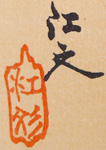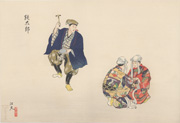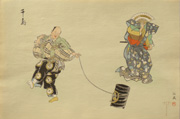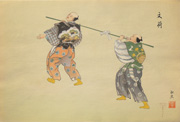Prints in Collection
IHL Cat. #623 | Kyōgen Gojūban, Dontarō, 1927 IHL Cat. #2536 |
| Kyōgen Gojūban, Nakiama, 1927 IHL Cat. #858 | Kyōgen Gojūban, Chidori, 1927 IHL Cat. #859 | Kyōgen Gojūban, Fumininai, 1927 IHL Cat. #860 |
Biographical Data
Biography
Tsukioka Gyokusei 月岡 玉瀞 (1908-1994)
Sources: The University of Pittsburgh comprehensive website on Tsukioka Kogyo http://digital.library.pitt.edu/k/kogyo/kyogen_gojuban.html; Guide to Modern Japanese Woodblock Prints: 1900-1975, Helen Merritt, University of Hawaii Press, 1992, p. 158 and as footnoted.
Tsukioka Gyokusei, the daughter of the artist Tsukioka Kōgyo (1869-1927), was born in Tokyo in 1908 with the given name of Fumiko 文子. Her married name was Inada Fumiko. She studied at the Women’s Specialist School of Fine Arts, graduating in 1929, and she studied Japanese-style (yamato-e) painting with Matsuoka Eikyu 松岡 映丘 (1881-1938), who worked to revitalize and modernize yamato-e.
Like her father she specialized in representations of Noh drama. After her father’s death in 1927 she completed the series, begun by her father, Fifty Kyogen Plays (Kyōgen Gojuban 狂言五十番), issued by the Tokyo publishing house Daikokuya (Matsuki Heikichi). She created 34 prints and the table of contents for this series, using the artist’s name Kōbun 江文. She also worked with shin hanga publisher Watanabe Shozaburo (1885-1962), creating thirty prints of Noh roles beginning in 1938, as wartime nationalism revived interest in Japanese theater.1 Other works credited to her include the series Scenes from Noh Plays, Series II2 done in 1931 and the c. 1930s series Hosho-ryu Noh Gaku Hanga (Noh Play Prints of of the Hosho School) again for Daikokuya.
In speaking about her father she commented:
Signatures
1 Modern JapaneseWoodblock Prints - The Early Years, Helen Merritt, University of Hawaii Press, 1998, p. 67.
2 This series is credited to her by The National Museum of Modern Art, Tokyo.
3 The Prints of Tsukioka Kōgyo, a brochure from the exhibition of the same name held at the Frick Art Museum February 3 - April 7, 2007.
Tsukioka Gyokusei, the daughter of the artist Tsukioka Kōgyo (1869-1927), was born in Tokyo in 1908 with the given name of Fumiko 文子. Her married name was Inada Fumiko. She studied at the Women’s Specialist School of Fine Arts, graduating in 1929, and she studied Japanese-style (yamato-e) painting with Matsuoka Eikyu 松岡 映丘 (1881-1938), who worked to revitalize and modernize yamato-e.
Like her father she specialized in representations of Noh drama. After her father’s death in 1927 she completed the series, begun by her father, Fifty Kyogen Plays (Kyōgen Gojuban 狂言五十番), issued by the Tokyo publishing house Daikokuya (Matsuki Heikichi). She created 34 prints and the table of contents for this series, using the artist’s name Kōbun 江文. She also worked with shin hanga publisher Watanabe Shozaburo (1885-1962), creating thirty prints of Noh roles beginning in 1938, as wartime nationalism revived interest in Japanese theater.1 Other works credited to her include the series Scenes from Noh Plays, Series II2 done in 1931 and the c. 1930s series Hosho-ryu Noh Gaku Hanga (Noh Play Prints of of the Hosho School) again for Daikokuya.
In speaking about her father she commented:
| I remember beginning at the age of fifteen going to the Kanze Noh stage at Omigari in Tokyo with my father. Before the play began, father would sketch the stage, beginning with the hashigakari. People around him were amazed at the speed and facility with which he drew…When father was absorbed with a painting, he worked with a fierce look on his face, and I knew not to enter his studio.3 |
Signatures
 |  |  |
1 Modern JapaneseWoodblock Prints - The Early Years, Helen Merritt, University of Hawaii Press, 1998, p. 67.
2 This series is credited to her by The National Museum of Modern Art, Tokyo.
3 The Prints of Tsukioka Kōgyo, a brochure from the exhibition of the same name held at the Frick Art Museum February 3 - April 7, 2007.




